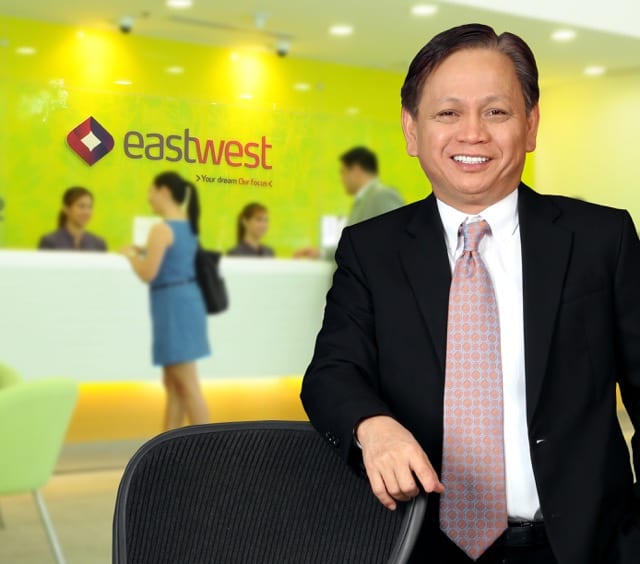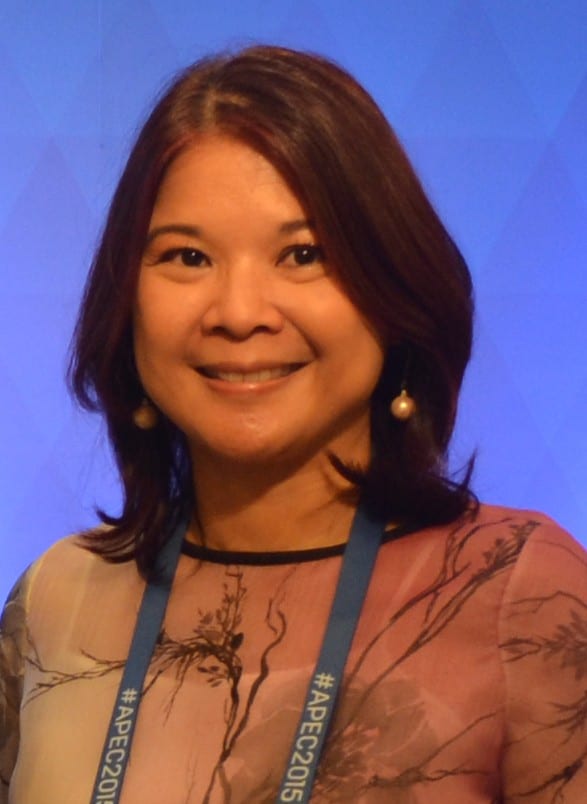
Q1: There are so many banks in the Philippines, yet, since 2012, East West Bank has opened around 300 additional branches in 3 years, what is your vision for East West Bank?
A. Our expansion was a necessary competitive response. We needed to expand quite massively because our competitors have much more branches. Otherwise, we will get clobbered. This is part of the vision set by the board to put EW among the ranks of the relevant banks. It started sometime in 2010. The board believed that the country will see favorable economic conditions that will likely continue far longer than what we have seen before. However, with better times, everybody will likely do some expansion. And that will result in heightened competition and put pressure on margins. That could even eventually precipitate consolidation. To stay competitive and be a consolidator rather than a ‘consolidatee’, EW will have to be bigger and more efficient than it was. That means EW should attain economies of scale. Since we are relatively smaller than most banks, we need to do it differently from how our competitors are expected to act. That is the reason why we built almost 300 branch stores in 3 years. It was a rather audacious yet untested approach then. We need the reach. We need to project EW nationwide. As a retail bank, the board saw this as the best path for EW towards attaining its vision of a Bank that is known as a good place to work for, for its service quality, and for competitively priced products and reasonable returns for investors. EW will be a Bank that is relevant to customers, employees, and investors.
Q2: Your business model is to focus on the consumer and middle market for loans with better net interest margin, which is highest among banks at 8.1%. How do you reduce your non-performing loans, especially from credit cards and personal loans, which is also highest among banks at 4.5%? Is this a calculated risk?
A. I don’t think this is a question of risk. We see it as one of strategy. Consumer loans have higher yields. However, those yields go together with NPLs. It is possible to lower NPLs and credit costs but that also means you will not grow fast. You cannot have your cake and eat it too. Nine years ago, EW had about Php4 billion of car loans and less than a billion of credit card receivables. Now, it is the 5th largest in terms of credit card receivables at Php22 billion and 4th or 5th in Auto Loans with size of close to Php30 billion. It also among the top banks in Personal Loans, a business it started less than 5 years ago. EW has remained profitable in spite of the huge costs of its massive branch store expansion. EW can choose to manage its NPL rate lower but it will have to accept slower growth and with less revenues in the future. We think it will be good for our stakeholders for EW to expand some more. There is always the need to balance between short-term profitability and growing the revenue base. The thing is, after all the yields and NPLs, where are our stakeholders better off? There is a sweet spot where the amount of NPLs optimizes returns. Below this optimal level, you give away revenues. Above this optimal level, you are incurring more bad loans than necessary. The lever to attain that sweet spot is credit policy. When you have too much NPL, you tighten credit policy to lower it. That will also almost necessarily mean you will have to lower the amount of loans booked. When you have too small NPLs, it could mean that you are not booking enough loans and leaving revenues on the table. Lower NPLs is not necessarily a good thing. We are managing for the future. We are building our revenue base to ensure the continuous stability of the Bank. You attain that by carefully balancing short-term profits and long-term sustainability. At some point in the future when the overall market growth normalizes and the portfolio matures, we expect to have better returns.
Q3: How do you balance between the need for low margin corporate accounts that can give you volume and mid market accounts that give you profit?
A. At the end of the day, what you are really after is to optimize the value of shareholders’ equity. You look at your assets and try to find the right mix that achieves this objective. This is the logic of all businesses, whether it is acknowledged or not. That is where low margin corporate accounts come in. It is one of those assets that give your balance sheet the diversification it needs to ensure its sustainability. Corporate accounts, in general, carry lower risks. Unlike the consumer portfolio that carries a lot of economic risks, or the risks that goes with what happens to the general economy, corporate accounts as an asset class has more resilience to the economic environment. The risks of corporate accounts are less affected by the overall economic situation than consumer loans. A combination of corporate and consumer loans balances the risks, optimizes returns and makes the balance sheet stronger. During bad times, corporate loans will have lesser losses. During good times, consumer loans will give better returns. The directional behavior of the two types of loans does not move together. Over the long run, investment returns will also be better and more stable with a diversified portfolio than say a purely corporate, purely middle market, or a purely consumer portfolio.
Q4: Proportion from your bank’s treasury income (as a % of net interest income) has been tapering off in the last few quarters from 33% Q2 ’14 vs. only 18% in Q2 ’15 (top banks have about a third of income from non-interest income). Has this shift been intentional? How can East West Bank continue being better than before in overall profit?
A. Yes, we do have lesser proportion of income from trading as compared to other banks. Yes, that is intentional. The proportion of our investments in fixed income securities, which is the main source of treasury income, is smaller than before. This is a reflection of prevailing market conditions, our risk management approach, and our market views. We believe that interest rates are about as low as it could get. We are being careful so that we will not be caught with lower yielding assets when the normalization of interest rates starts. We also note that the yield on fixed income securities offer very little, and sometimes, even negative return vs. some funding. When the interest margins on securities improve, we may put in more in our balance sheet. Another reason why the proportion of treasury income is falling is because our net interest income is growing very fast. Thus, even if securities portfolio level is the same, if income from loans increases, the proportion of securities income will fall. Please note that we do not put into loans what we have not invested in securities. Instead, our ‘under investment’ in securities is reflected in low leverage in terms of Total Assets to Total Equity ratio and high Tier 1 ratio. We have lower leverage and higher than industry Tier 1 ratio.
Our returns have fallen, not because of NPLs, and lower Treasury income. In absolute levels, our revenues have increased. Our return on equity is lower mainly because of the costs from our massive expansion and also because we are paying more taxes now. It takes time for the branch stores to mature. In the meantime, we still have to pay salaries and incur marketing, sales and other operating expenses. This is a timing issue where costs are upfront and revenues lag. When our branch stores mature and we start getting close to the level of our competitors, we expect profitability to improve. In 2012, during our IPO, we have been upfront and shared these expectations with our investors as a necessary phase in EW’s growth plans.
Q5: What does East West Bank brand stand for? What is East West Bank’s brand promise to its customers?
A. The branding exercise we did a few years back is about ‘making good things happen’ for our customers. The EW brand promise is to assist customers on the financial side of their dreams. By customers, we mean the market segments we have identified – broadly the consumers, mid market corporates, and the mass affluent. Our major products – middle market working capital loans, trade finance, cash management, auto loans, credit cards, personal loans and mortgage have these market segments in mind. We are likewise building our investments offerings to mid and small investors. We consciously project dynamism and fresh approaches through our colors and appropriate imagery.
Q6: You need your employees to deliver the bank’s brand promise. How do you create employee engagement, especially with most of them located in over 400 branches outside your head office?
A. We are an almost 6,000 strong organization now. Everyone should be a brand ambassador but it is obviously not easy to do that. I wholeheartedly share the belief of those who say that getting employees engaged is the most important task of the management team. Engaged and committed employees can accomplish anything. They will constantly try to learn and improve their competencies so that they could serve customers better. They will cooperate and work well with their work comrades. They will protect and help enhance the image of the Bank. In short, an engaged organization will do all that is needed to succeed.
So how do we achieve that? The tone is always set from the top. That is why it is important that senior executives embrace the values and brand proposition of the Bank. We need to ‘walk the talk’. It is also premised that there must be clarity on organizational purpose. With that, we should attain commitment and eventually, the preferred behavior.
When you start with these fundamentals and are able to do it properly, then communication should go through more effectively. It will be easier to relate to the brand promise and for it to resonate across the organization. This could happen even if employees are located far from each other. Coming out with brand standards and guidelines, and power point presentations, and things like brand credos that go with branding exercises are needed and important, but these are not enough. These are the things that brand consultants can help you with. It is brainpower. But commitment and engagement is a battle for the hearts of people in the organization. It is the heart, in Filipino, ‘Puso’, that leads towards engagement and action.
This will always be a work in progress. We are aware that we are not anywhere near where we want to be. We recognize that we have a lot of work before us. If done right, it will manifest in a positive culture. If one is wrong, it will manifest in a difficult culture. It defines the organizational character. In an ever changing and very competitive world, an engaged organization will be a key competitive advantage. Then, it is possible to achieve the branding imperative – bringing the brand to life everyday is everyone’s job.
Catch Tony Moncupa, Jr. LIVE (rare appearance, rare insight sharing) at the 11th Mansmith Market Masters Conference, happening on March 18, 2020 at Resorts World Manila. Register early (pay in January 2020). Visit www.marketmastersconference.com.


